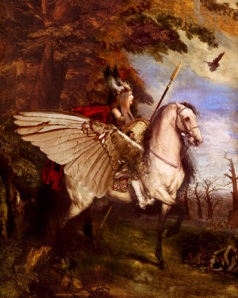FF#4 Question: Have you ever used a fictional character as a archetype or patron goddess?
When I started writing this, I thought my answer would be “no” but as it turns out… I gave it some thought and realized I have consistently been doing this for years. I have adapted fictionalized versions of historical/mythical women as archetypes and ancestresses.
The first female figure that came to mind is Morgaine from The Mists of Avalon series (Marion Zimmer Bradley) was the first of these to come to mind. I picked up this book when I was pregnant with my first child, and the magick that she performs both in the act of conception, and during her pregnancy, has inspired some of my own ritual workings in very real ways. I never shared her despair in pregnancy to the extent that she does, but her interaction with the realm of the Fay reminded me of otherworldly encounters when I was enduring the darkest hour of my life. Mordred and Morgaine have been cast as such pure villains in other versions of this story, I really enjoyed seeing them depicted as magical humans. Mists of Avalon doesn’t exactly turn them into figures of sweetness and light, mind you. Mordred gets almost universally cast as evil in the Camelot cycle, his character twisted somehow by his parentage and their “unholy” union. I still get a haunted feeling when I look at images of Morgaine from the film or in fan art, especially with Mordred as a boy.
Then I remembered Dinah from The Red Tent by Anita Diamant. I read this book when I was in college, years before Mists of Avalon, in a time when I was sort of lost when it came to my pagan practices (I had reverted to being in the closet because there were no active groups in my area, and out of respect for the wishes of my best friend at the time, who was concerned that people in the community would judge her if I was out of the broom closet. I now have my own independent existence and decided people can either take it or leave it). Dinah is the only female sibling mentioned in the story of Joseph (of Technicolor Dreamcoat fame) and his brothers who later became the patriarchs of the twelve tribes of Juday; she is only mentioned in the Old Testament briefly, as being abducted and raped. In the fictionalized version by Anita Diamant, Dinah absconds with a Gentile prince, and is actually kidnapped by her brothers and returned home against her will (and possibly starting a war in the process, though it’s been some years since I read it). I started working with Dinah as an archetype for empowerment in espousing broader world views than my patriarchal tradition had handed down, and for working with ideas of inter-cultural marriage. It took some years, but I feel that her character is very real in figuring into breaking down the unnecessary structures left by that world view in my life.
Another work of fiction that I read in college that changed my life was The Wolf and the Raven, by Diana Paxson. When I made her acquaintance in 2008 at a Goddess Spirituality retreat, I had to gush to her just a little about how her storytelling really brought the figures of Brunahild and Sigfrid to life for me (she expressed surprise that I hadn’t yet picked up a copy of Mists of Avalon, which she has been working on sequels to, and I felt a little embarrassed having not read that – but, as I mentioned above, I have since read the whole trilogy and loved it). Diana’s portrayals of the Valkerie and the AllFather, especially, were formative for me in future work with them. Her book was also the first piece of fiction I had found that really opened up the meanings of the runes to me. I felt more connected to my Germanic heritage through reading that novel, to boot. I recommend it for anyone who is interested in the rich lore behind Wagner’s Ring of the Nibelung cycle, or who is studying the Teutonic/Norse pantheon, or whoever simply likes a well-told story.
Death and Delerium from Neil Gaiman’s The Sandman series are also female figures I have worked with.
All of these relationships have been very informal (except in the case of the characters from The Wolf and the Raven, as a result of which I was spiritually initiated as a Daughter of Odin), but I think I will begin revisiting these fictional heroines in a more serious light. It can be invaluable to have “real life” examples of real women facing and dealing with hardships, and working with their figures in ritual potentially yield interesting, empowering, and very effective results.
As I’ve been proofreading this article, I had another memory. The book Wait Till Helen Comes, as dark as it was, featured a ghost named Helen who actually helped me, as an eleven-year-old girl, in embarking on relationships with the dead. I would have to reread that book to recover many more of the memories I have of that work, but there is the shadow of remembrance, that she came alive for me, so to speak. Perhaps it wasn’t her character at all, but a local spirit that I invited to be a guide for me at that time. It was kind of a scary experience for me, since the character of Helen isn’t exactly someone you would call a higher being.
I welcome any and all constructive comments. Thank you for reading!
